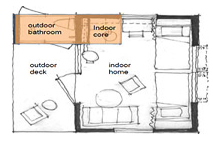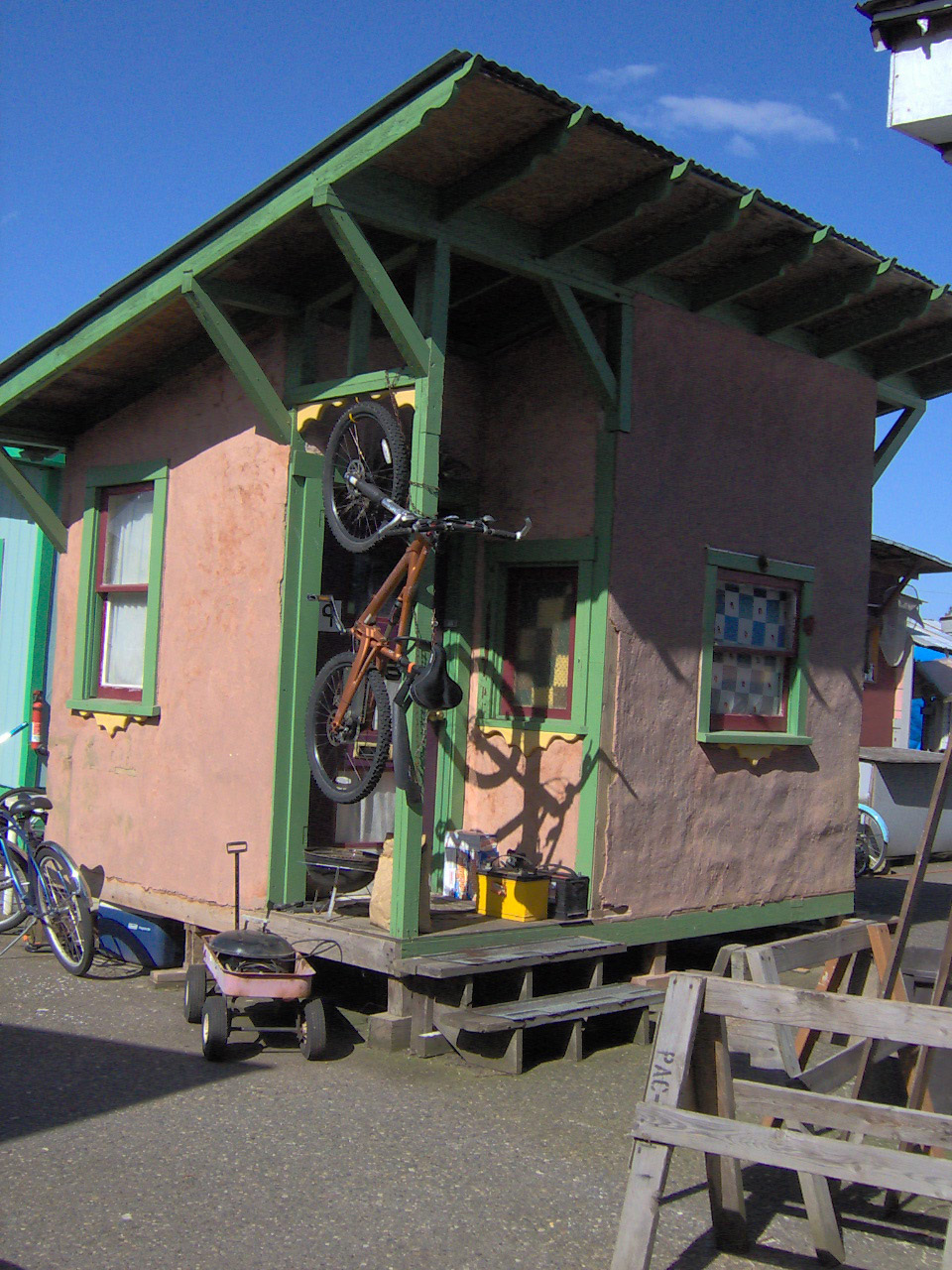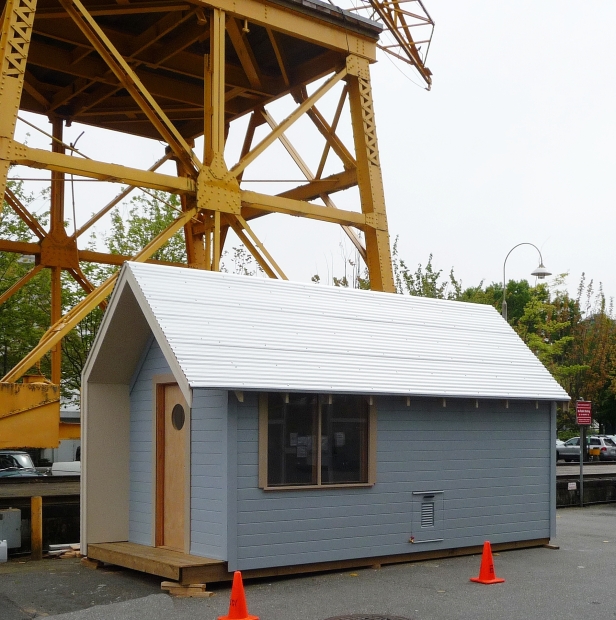The folks at faircompanies tipped me off to an interview they recently had with Daniel Gross, the entrepreneur behind a company called WorldHaus. WorldHaus, an Idealab project, has developed a low cost prefab building system intended to provide families in places like Kenya and India a safe and secure place to live for as little as $1,000.
It sounds like a wonderful idea but the interview left me questioning some bigger issues their research surfaced.
Here’s a quote from the latter half of the interview:
“It (natural building materials) fails in the aspirational standpoint, which means, a lot of people love the idea of bamboo, they love the idea of earth houses but it’s not something they want to pay for to live in, it’s not their dream house. We’ve yet to find a natural material that when we go to villagers and we say – how about a house made out of this – it’s something they are actively willing to pay for. And that’s one of the key building blocks of WorldHaus and one of the key areas we’re going into is – we want something that people will want to pay for and want to finance.”
I hesitate to pass judgement on the project since there’s not much information about their house kit or the research they performed available on the WorldHaus website. But knowing that most people around the globe live in homes made from natural materials I was surprised to hear that they would prefer to pay him for a prefab home.
So instead I’m just going to say that I’d personally hope to see more projects focused on using local materials and labor instead of manufactured homes shipped by the hundreds to remote locations in shipping containers.
Two great examples come to mind immediately.
Earthbag Roundhouse
This earthbag roundhouse in Thailand was built by Owen Geiger (and team) for just a bit more than $2,000. It’s made from local materials and was assembled by local people. The end result looks like a wonderfully comfortable small home. The best part is that once people learn how to build with earthbags there’s little stopping them from building more.
Arial Home Initiative
The Arial Home Initiative is focused on bringing prefab construction methods to local communities. Instead of shipping prefab panels to developing nations they teach people how to make the prefab panels themselves. The houses go up in no time and cost very little money.
![]()
It’s hard to say if approaching housing challenges in developing nations would be more successful by taking a capitalist approach – or if an altruistic teach-a-person-to-fish approach would come out ahead. Like I said above, I’d hope the altruistic approach would win but who knows, maybe more people can be served by running it like a businesses.
Tough call.
In any event it will be interesting to see how successful WorldHaus becomes and how these kit homes perform for their owners.





I agree Michael. Local materials is always better.
And I question his “research” about the use of natural materials. It’s an “aspirational issue”? Um no, it’s the western world forcing it’s viewpoint on what a home is, what a home is defined as.
The collective “we” don’t think the use of natural materials is equivalent to quality. “Why would I want to live in a home made of dirt? Look at them…”
Argh, I hate the fact that many companies try to force “our” definitions on the rest of the world.
I have a saying that it cost more to be poor than to be rich. The rich have free bank accounts and the poor are charged a monthly fee. The rich get benefits that the poor do not all across society. Including, the third world countries. How many kids will be prostituted to pay the $20 rent a month? $20 doesn’t seem like much to you or me but to them that is a lot of money. That is why we should be shining a light on natural building and actively seeking to improve it. If people in poor countries can build a free house from local materials why should they suffer in vein to pay for a $1,000 house? This is just another way to exploit people who are in need. Companies and corporations can’t make money from natural houses can they?
“Companies and corporations can’t make money from natural houses can they?”
Exactly! While they (corporations) have been able to do amazing things ‘advancing’ technology and science they’ve done it at an enormous cost.
Taking a business approach to housing may put roofs over heads I fear it will come at the cost of short term gains for the rich and long term costs for everyone else.
Terry Pratchett revealed an interesting explanation of this philosophy in one of his books explained as follows:
Boots come in $10 and $50 versions. The $10 version will last about 2 months, maybe 6 if you’re prepared to replace the cardboard soles, but the $50 version will last a lifetime. A poor copper can only afford to buy the $10 boots, but will need to replace them frequently. Over 10 years, the poor copper will spend $200 on boots and still have wet feet while the rich man will spend $50 on boots and can expect another 10 years of dry feet to follow.
It’s a nice explanation on how having more money enables you to spend less.
A direct parallel in housing would be building quality. Having more money would let you build a house with better insulation and tighter air sealing, more efficient windows and doors etc. In the long-term this will save money on heating and cooling costs. Amortised over a 25 year period you’d spend less than someone who built a cheaper shell and spent more to heat it.
When I lived in Japan more than 20 years ago I found the local people wanted what we Americans had (or what they thought we had). We ended up wanting a lot of what they had. So, I would imagine that if a team of people go to a poor area and ask the people what they’d like, it wouldn’t be a home built out of local stuff. They want the “nice stuff” like we have. I think they need to ask different questions or show different ideas and like in any poll, the answers would change. I think local materials built with modern thinking would be best.
I suspect you’re right, after all even “we” (majority of Americans) want what we think can be obtained (like what we see on TV). Seems the marketers have us all a little brain washed, like some big comsumer cult.
Did I just go too far? 😉
Nowhere near far enough. I mean that, too.
But the thing is, when you ask yourself how many Americans are living in homes built from natural material…. Welll, very few. And yet at the same time, it is ture that a lot of it is demonstrably due to the corporate manipulation of people and the political system. And you have to include the fact that you are not allowed according to the zoning bylaws, to build such a thing.
Everyone here likely knows that, but somebody seeing America on TV or visiting would not know.
That said I am not so quick to jump to conclusions about natural material being so much better, or that companies cannot make money off of them.
Earthcrete, for instance, has many patents on it, and they can still sell designs, equipment etc., there are a lot of ways to make money.
But we cannot even start to explore the answers to the questions that surround them, if they might be better or not, or how to use them, when building with them is prohibited by law.
oh, well it’s not just corporations, not quite accurate to blame them alone. These days I trend towards blaming the “predatory class” – a term coined by economist James K galbraith, which includes the ceos, corp board members, and the politicians that cooperate with them in their unethical endeavors.
I think you summed that up very nicely. I did the interview with Daniel and was uncomfortable with how it turned out as anytime someone brings up “research” it’s as if there’s some sort of empirical rightness to it, but as you point out, it all depends on how you phrase your questions.
I actually have videos of earth homes that are very “aspirational”. I shot a series with Michael G. Smith- a natural builder/author- who showed me the homes they have constructed on their intentional community in Northern California. These homes much closer to the average American home- if not nicer. I’d be curious what the reaction would be if these were the example homes shown in the research.
If you’re interested, here is a link to one of the videos: http://faircompanies.com/videos/view/a-return-to-natural-building-cob-straw-bale-earth-etc/ Michael talks about how he thinks those of us in the U.S. will build with more natural materials as the cost of traditional materials rises with the cost of fossil fuels.
There may be merit in this particular company but in general I agree, local materials are preferable. Not only do you usually end up with a better house and lower resource impacts, you also foster more self-reliance and possibilities for locals to make a living without being trapped into long term debt. My parents preferred store bought white bread to their home made dark peasant bread when they first came to Canada, now they’re reluctant to admit the kids and grandkids are smart to go back to the ‘real’ bread. They were influenced not just by the ads but a whole lot of social pressure from their peers who also fell for the false images. We need to make people with intelligent solutions to real world problems the heroes to emulate, not conspicuous consumption obsessed celebrities and paid influence peddlers.
“There may be merit in this particular company but”
I agree. With the evidence available it’s tough to confidently pass judgement on this particular fellow. I’ve not spoken to him so I don’t know if he’s a capitalist trying to sell a dream -or- a humanitarian taking a business approach to a housing issue.
I do wish that one of his core requirements was to use local materials and labor instead of marketability and shipping efficiencies.
Maybe with feedback from communities like ours he’ll rethink some of his core goals. After all you never know until you know.
“capitalist trying to sell a dream”
This reminds me of that presentation about the Lifebottle – in which the presenter made most laughably transparent and absurd attempt at this I have ever seen, suggesting that billions of dollars of lifebottles be sent to the developed world, at several hundred bucks a pop.
Hint: There are things like the lifestraw that do the exact same thing for all practical purposes for $2. And clean water infrastructure is also far cheaper. And the technology in the lifebottle is arguably more than 25 years old, although the membranes keep getting better….
That brings to mind the Potters for Peace water filters http://en.wikipedia.org/wiki/Potters_for_Peace http://s189535770.onlinehome.us/pottersforpeace/wp-content/uploads/filter-project-guidelines.pdf and the concept of a social franchise.
I think a few of the comments above miss the point completely. The aspiration aspect is from the view of the villager’s mindset. The speaker has done the surveys and asked about natural building and the market is dictating back to him that that is not what they desire or aspire.
Far better to have something they want and will build and adapt to their aspirations than market a product that fails because it fits none of their desires.
Local labor,bare bones framing,material choices of local materials will evolve with time and lend itself to a village of better housing and happier villagers.
Robert of the Bungalow Woods
Yes, but WHY do they have these aspirations? Is it based on reality or manufactured of illusory desires? Ask a roomful of kids if they want ice cream and cake for supper you’ll likely get a yes. Does that make it the best option? I am in no way trying to say that villagers are children, just using the imagery to make a point about what people say they want. If it’s possible to make housing of equal quality from local materials using better designs was that an option offered, or was it only a contrast between inadequate current local housing and the imported shiny new model?
It has been shown in instance after instance around the world That pride of ownership in a house that suits the aspirations of the villagers leads to a better maintained and happier community.
Getting roofs over their heads is the object.
I don’t think the speakers object is to be a capitalist forcing Western norms, he is merely explaining the realities.
By getting housing that people want and desire and likewise schools designed to their aspirations, the standards of living and education will rise.
Eventually that will lead to forward thinkers in their communities pioneering the use of natural local materials that look like you would want to live in.
The current Revolutions in the Middle East are not just cries for freedom they are cries yearning to be like us. Or the us we should aspire to be as I put it. A neat little clean solar powered house with safe cooking and heat for $20 a month is the speakers goal. How that is capitalistic puzzles me,how it is forcing people to have aspirations beyond reality is also beyond me.
I am all for local natural material. Live in an off grid tiny house,practicing locavore,solar energy advocate. The life style suits me.s However at times you need to give people(and children) what they want and over time teach them what they need. That is how the current trend in tiny houses was born.We are being dragged backwards and they are being dragged forwards towards a more sustainable future.
Robert of the Bungalow Woods
WorldHaus: Sounds like faulty research to me. If you ask poor people if they want to live in houses made of earth, and the houses in the area, which are made this way and falling apart, then sure, they’ll vote for the ‘shiny solution’, especially if they’re unaware of the offgassing, high embodied energy, etc.
Show them beautiful examples of homes made of natural materials and you’ll get an entirely different response.
Also, I see no reason why you can’t make a profit building homes with natural materials if you’re outside the restrictions of building codes that adversely affect cost of construction. Example: builders/carpenters made a living for thousands of years building homes with natural materials (and many still do).
Seems like a no-brainer to me. Let’s say we do really get to 9 billion on this planet and everyone needs shelter. Could anyone manufacture enough to house this many people? No, materials will have to come from the earth and all designs and manufacture will have to be local.
It’s not about what we aspire to, it will be about what is available, affordable and scalable. The so-called developing nations ( who’s to say which world is in most need of ‘development’?)
I dare say that this will also occur in the ‘developed’ nations as access to cheap energy and easy resources will quickly diminish in the coming years.
Natural building materials will and must return to the vocabulary of shelter and building techniques must be accessible to a large number of people with little training.
I think the key phrase here is, “natural materials that they are willing to pay for”. Many of these people are used to building their homes from natural materials they can go out and get anywhere. So, why should they pay these people for them?
The earthbag homes sound like a good idea at first – they look nice when they’re first completed. But, the earth has seeds in it – and the will grow.
I have been researching affordable housing for the poor for a few years, since I lived abroad and saw the homelessness problem firsthand. I liked the idea of earthbag homes, but after some more research, I saw that they don’t hold up longterm because the seeds grow and destroy the structure. I wish I had the link to show you the result after a year or two – maybe someone can find it.
i have small budget about 400000 to 500000 lakh rupees in small village which materila i prefare or prefabriacted homes